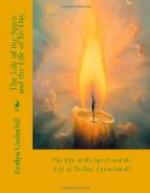If we could get rid of the idea that the unconscious is a separate, and in some sort hostile or animal entity set over against the conscious mind; and realize that it is, simply, our whole personality, with the exception of the scrap that happens at any moment to be in consciousness—then, perhaps, we should more easily grasp the importance of exploring and mobilizing its powers. As it is, most of us behave like the owners of a well-furnished room, who ignore every aspect of it except the window looking out upon the street. This we keep polished, and drape with the best curtains that we can afford. But the room upon which we sedulously turn our backs contains all that we have inherited, all that we have accumulated, many tools which are rusting for want of use; machinery too which, left to itself, may function satisfactorily, or may get out of order and work to results that we neither desire nor dream. The room is twilit. Only by the window is a little patch of light. Beyond this there is a fringe of vague, fluctuating, sometimes prismatic radiance: an intermediate region, where the images and things which most interest us have their place, just within range, or the fringe of the field of consciousness. In the darkest corners the machinery that we do not understand, those possessions of which we are least proud, and those pictures we hate to look at, are hidden away.
This little parable represents, more or less, that which psychology means by the conscious, foreconscious, and unconscious regions of the psyche. It must not be pressed, or too literally interpreted; but it helps us to remember the graded character of our consciousness, its fluctuating level, and the fact that, as well as the outward-looking mind which alone we usually recognize, there is also the psychic matrix from which it has been developed, the inward-looking mind, caring for a variety of interests of which we hardly, as we say, think at all. We know as yet little about this mysterious psychic whole: the inner nature of which is only very incompletely given to us in the fluctuating experiences of consciousness. But we do know that it, too, receives at least a measure of the light and the messages coming in by the window of our wits: that it is the home of memory instinct and habit, the source of conduct, and that its control and modification form the major part of the training of character. Further, it is sensitive, plastic, accessible to impressions, and unforgetting.
Consider now that half-lit region which is called the foreconscious mind; for this is of special interest to the spiritual life. It is, in psychological language, the region of autistic as contrasted with realistic thought.[85] That is to say, it is the agent of reverie and meditation; it is at work in all our brooding states, from day-dream to artistic creation. Such autistic thought is dominated not by logic or will, but by feeling. It achieves its results by intuition, and has its reasons which the surface




